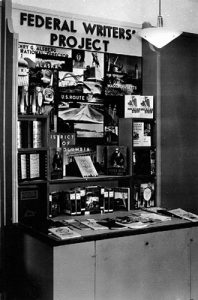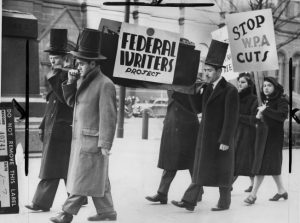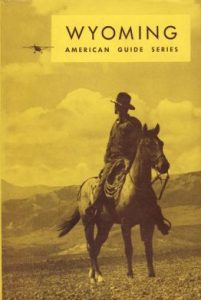 When times get tough, new ideas are needed to get people through them. The Great Depression put many people out of work. Times don’t get much tougher than that. The government decided to try something new. The project that was put forward was the Federal Writers’ Project (FWP). The idea was to fund written work and support writers during those dark days. The project was deigned to be in operation from July 27, 1935 to October 1939. It was part of the Works Progress Administration, a New Deal program.
When times get tough, new ideas are needed to get people through them. The Great Depression put many people out of work. Times don’t get much tougher than that. The government decided to try something new. The project that was put forward was the Federal Writers’ Project (FWP). The idea was to fund written work and support writers during those dark days. The project was deigned to be in operation from July 27, 1935 to October 1939. It was part of the Works Progress Administration, a New Deal program.
Of course, this was not really designed to allow people to explore the idea of becoming a writer, but rather to ease the plight of the unemployed writer, and anyone who could qualify as a writer such as a lawyer, a teacher, or a librarian. As the Roosevelt Administration ironed out the details of the New Deal, the administration and writers’ organizations and persons of liberal and academic persuasions felt that somehow, they could come up with more appropriate work situations for this group, the writers, other than blue collar jobs on construction projects. The final project was for one all the arts, which was called Federal One. As part of President Roosevelt’s Second New Deal, Federal One was divided into five specialties…writers, historical records, theater, music, and art. Each specialty was headed by professionals in that field.
The Federal Writers Project was first operated under journalist and theatrical producer Henry Alsberg, and later John D Newsome, who were charged with employing writers, editors, historians, researchers, art critics, archaeologists, geologists and cartographers. Some 6,600 individuals were employed by the project compiling  local and cultural histories, oral histories, children’s books, and other works. The most well-known of these publications were the 48 state guides to America known as the American Guide Series. These books contained detailed histories of each state with descriptions of every city and town. They also contained a state’s history and culture, automobile tours of important attractions, and a portfolio of photographs. In each state a Writer’s Project staff was formed with editors and field workers. Some offices had as many as 150 people working, a majority of whom were women. Staff also included several well-known authors of the time and the program helped to launch the literary careers of others.
local and cultural histories, oral histories, children’s books, and other works. The most well-known of these publications were the 48 state guides to America known as the American Guide Series. These books contained detailed histories of each state with descriptions of every city and town. They also contained a state’s history and culture, automobile tours of important attractions, and a portfolio of photographs. In each state a Writer’s Project staff was formed with editors and field workers. Some offices had as many as 150 people working, a majority of whom were women. Staff also included several well-known authors of the time and the program helped to launch the literary careers of others.
Though the project produced useful work in the many oral histories collected from residents throughout the United States, it had its critics from the beginning, with many saying it was the federal government’s attempt to “democratize American culture.” Though most works were not political, some writers who supported political themes sometimes voiced their positions in their writings. This led some state legislatures to strongly oppose some projects and in a few states the American Guide Series books were printed only minimally. As the Project continued into the late thirties, criticism continued and several Congressmen just wanted to shut the project down. In October 1939, federal funding for the project ended, due to the Administration’s need for a larger defense budget. It was decided that the project could continue under state sponsorship, but even that ended in  1943. I’m sure that was due to World War II, and all that was needed to be poured into the war effort.
1943. I’m sure that was due to World War II, and all that was needed to be poured into the war effort.
While I am not really a fan of the government manufacturing jobs, I think that some of the great writings that came out of the Federal Writers Project, made this project one of the better government funded job ideas. During its existence, the project included a rich collection of rural and urban folklore, first-person narratives from people coping with the Depression, studies of social customs of various ethnic groups, and over 2,300 first person accounts of slavery. In documenting the common people, a number of books emerged from writers on the project including Jack Conroy’s The Disinherited and John Steinbeck’s classic The Grapes of Wrath. While this project was certainly unorthodox, it makes you wonder if we would have missed out of some great books, had it not been for this program. When the project ended, there were actually protests in an effort to keep it going, but it had run its course, and in 1943, it ended.


Leave a Reply